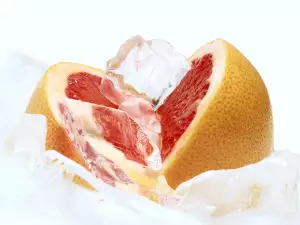Pomelo is often called the king of citrus. This incredibly useful and yet juicy and tasty fruit was known to people around 4000 years back in time, the Chinese first began to grow pomelo. For thousands of years pomelo consumption in Asia had become a strong tradition, now the Republic of China even has a state program for the use of the fruit. Numerous positive influences on human organism are offered by pomelo, and this "Citrus Wonder" features an excellent taste.
What is a pomelo?

In essence, pomelo is an evergreen tree which bears huge citrus fruit that has no equal in its size among all citrus. Pomelo fruit is round, the skin is often quite thick. The more mature the fruit, the thinner is its sheath. Ripe fruit has bright yellow rind and unripe is usually greenish. The largest citrus in the world reaches significant proportions.
Pure fetal weight (without skin) is about 70%. In rare cases, a tree to bears fruits, sized up to 10 kg. In diameter, it is usually between 10 and 30 cm and in most cases up to 8 kg. The interior is hollow, broken into pieces, like other citrus fruits, with thick and fleshy membranes. In general pomelo has no seeds, but some of the new varieties are no exception to this rule. The original taste of pomelo is very sour and bitter, but new varieties are characterized by milder taste.
Its home country is believed to be in Southeast Asia, namely Malaysia. First of these juicy citrus trees grew on the islands of Tonga and Fiji. In China it is known since around 100 BC. Mariners brought it to Europe in the 14th century. Captain Sheddok brought seeds for pomelo into the West Indies from the Malay Archipelago in the 16th century and for some time, the fruit was called by his name.
There are opinions that because of its bitterness, for a long time pomelo is only consumed the Indonesian peninsula. Ten years ago European specialists created new varieties that in several years can already be harvested. These new varieties of pomelo are not as juicy but quite sweet, you almost do not feel the sour taste. That is why pomelo rapidly begins to gain popularity and is well accepted in the western market.
Most useful are large light yellow fruits. The good news is that pomelo fruit is durable. If you buy it underripe, you can leave it for a few days to a week to soften and enhance the taste and health qualities.
Cultivated varieties have a fragrance similar to that of grapefruit, but not the astringent and bitter taste streak. That is why, pomelo is often called "honey grapefruit." The name itself comes from the Danish word for grapefruit - pompelmoes.
Currently, pomelo is grown mainly in southern China, Thailand, Taiwan, southern Japan, Vietnam, India, Indonesia, the islands of Tahiti and Israel. Plantations of pomelo trees are already in some European countries as well as in California, but they are not as big in production, as Asian plantations.

Types of pomelo
The main varieties of pomelo are five: Khao horn, which are yellow outside and bright green color, sweet interior; Khao namphung is pear-shaped, yellow green shell, the inside of the fruit is light and sweet, variety Khao paen has flattened, oval, yellow, green crust and the interior of this variety is bright and slightly acidic, type Khao phuang a pear-shaped, bark greenish yellow with a sweet and sour taste, the color of the interior is yellowish white; variety Thongdi are spherical, dark green skin, the fruit is very sweet and pinkish.
Composition of pomelo
Nutritional values for 100 g pomelo: 36 calories, 0 g fat, 0.7 g protein, 9.1 g carbohydrates, 58 mg vitamin C, 1 g fiber, 205 mg potassium, 1 mg sodium.
Pomelo is the richest source of vitamin C, from which a number of benefits to the human body originate. Moreover, pomelo fruit contains a significant amount of vitamin A, essential oils, antioxidants and micronutrients.
Selecting and storing pomelo
Pomelo can now be purchased in almost any shop or stall for fruit and vegetables. To make sure that the pomelo is fully mature, choose yellow fruit with a nice crust. Avoid any sign of deterioration - dark spots or wrinkling of the skin in certain areas.
Pomelo fruit is very durable, so if you sometimes buy poorly ripened pomelo, quietly leave it for a few days to ripen. No need to refrigerate.
Culinary use of pomelo
In almost all cases, the pomelo is consumed as fresh fruit. You can turn it on some fruit salads and desserts. Use it for fruit juices, which are delicious and very useful.
Grated peel of the pomelo is added to jams, syrups and marmalades. If you want to get ab exotic taste in your dishes, add pomelo to your vegetable salad, salad with seafood or garnish for fish dishes and other delicious dishes.
Benefits of Pomelo
Being rich in essential oils and antioxidants and vitamin C makes pomelo into a useful aide in the fight against viral diseases. Pomelo contains lipase enzyme that helps digestion and absorption of proteins, which in turn is the reason this is a perfect food for athletes. Has many have proven antibacterial properties. Pomelo juice can be used in the treatment of hypertension because it reduces high blood pressure. Acts preventively against cancer. Pomelo is the suitable option for diets for weight loss.
Regular consumption of pomelo is an excellent health choice. The Chinese believe they largely owe their vitality and youthfulness and immune system, namely to pomelo. Tea of pomelo even be used as a preventive measure against bird flu. For New Year, Chinese give it as a symbol of wealth and prosperity, and among work groups in China, there is a widely spread practice to organize competitions in speed eating of pomelo. According to the Thai, pomelo even treats asthma and tuberculosis, is excellent in the fight against cancer and make people satisfied and happy with your self and life.


















Comments